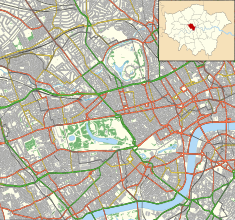Marlborough House
| Marlborough House | |
|---|---|
King Charles III in the right of The Crown | |
Listed Building – Grade I | |
| Designated | 5 February 1970 |
| Reference no. | 1331701 |
51°30′18″N 0°8′9″W / 51.50500°N 0.13583°W Marlborough House, a Grade I listed[1] mansion on The Mall in St James's, City of Westminster, London, is the headquarters of the Commonwealth of Nations and the seat of the Commonwealth Secretariat. It is adjacent to St James's Palace.
The house was built in 1711 for
Construction

In 1708, the Duke of Marlborough was granted a 50-year lease of the site from the
In 1727, Sarah's political rival
In the 1770s, the 4th Duke of Marlborough hired the architect Sir William Chambers to add a third storey to the house and architectural details like new ceilings and chimneypieces.[9][10]
Royal residence

After the fourth duke's death in 1817 ownership was taken up by
After Leopold became king of Belgium and left Britain, Marlborough House continued to be primarily used by members of the
From 1861 to 1863, Sir
After his father moved to Buckingham Palace in 1901, Edward VII's son George, now Prince of Wales, took up residence with his wife

In 1936, Marlborough House became the London residence of George V's widow, Queen Mary, who survived George by 17 years. In the grounds of the house remains her pet cemetery. A thatch-roofed rotating summer house built for her is still in place.[20] A plaque to commemorate Queen Mary was unveiled by Queen Elizabeth II in 1967 on the exterior wall closest to the corner with the Mall.
Commonwealth Secretariat
After Queen Mary's death in 1953, Marlborough House continued to be used by various members of the royal family as a London residence before Queen Elizabeth II leased it to the Commonwealth Secretariat in 1965, an arrangement which continues today.
The Gambia Independence Act 1964 was signed at Marlborough House, before its independence on 18 February 1965.
Features
The nearly cubical saloon retains wall-paintings by
Public opening times
Marlborough House is usually open to the public for
See also
- Noble Households – book with Marlborough House inventory of 1740
References
- ^ Historic England. "Grade I (1331701)". National Heritage List for England. Retrieved 4 April 2009.
- ^ a b Searle, Arthur (1982). "'A Pleasing Example of Skill in Old Age': Sir Christopher Wren and Marlborough House" (PDF). British Library Journal. pp. 37–44.
- ^ a b "Old and New London Vol. 4: Pall Mall". Cassell, Petter & Galpin. 1878. pp. 123–139.
- ^ Dictionary of British Sculptors 1660-1859 by Rupert Gunnis
- ^ "Marlborough House opens its doors to the public". thecommonwealth.org. 6 September 2011. Retrieved 10 October 2020.
- ^ Glinert, Ed (2012). The London Compendium. Penguin. p. 231.
- ^ Stourton, James (2012). Great Houses of London. Frances Lincoln Ltd. p. 32.
- ^ "Pall Mall, South Side, Past Buildings: No 71 Pall Mall, Sir Edward Walpole's House". London County Council. 1960. pp. 378–379.
- ^ Stourton, 2012; p. 35.
- ^ Glinert, 2012; pp. 230–231.
- ^ ISBN 9780140710120.
- ^ Pirenne, Henri (1948). Histoire de Belgique (in French). VII: De la Révolution de 1830 à la Guerre de 1914. Maurice Lamertin. p. 26.
- ^ Greenwood Map of London 1830. Archived 3 March 2016 at the Wayback Machine.
- ^ Sheppard, F. H. W. (1960). "Pall Mall, South Side, Past Buildings: Nos 66–68 (consec.) Pall Mall: The Junior Naval and Military Club". Survey of London: volumes 29 and 30: St James Westminster, Part 1. Institute of Historical Research. Retrieved 3 April 2013.
- ^ Vovk, Justin C, Imperial Requiem: Four Royal Women and the Fall of the Age of Empires, p. 158.
- ^ Physick, John (1982). The Victoria & Albert Museum: The History of its Building. p. 16.
- ISBN 978-0712617994.
- Oxford Dictionary of National Biography, Oxford University Press, 27 May 2010. Retrieved 26 October 2022.
- ^ a b Stourton, 2012; p.36.
- ^ "Marlborough House Gardens Virtual Tour". Commonwealth Secretariat. Retrieved 26 February 2012.[permanent dead link]
- ^ "Orazio Gentileschi (1563-1639) & Artemisia Gentileschi (1593-1652) - An Allegory of Peace and the Arts". www.rct.uk. Retrieved 7 October 2020.
- ^ "Marlborough House opens its doors to the public" (Press release). Commonwealth Secretariat. 6 September 2011. Retrieved 20 January 2019.
Bibliography
- OCLC 938151474
- Murdoch, Tessa (ed.) (2006). OCLC 78044620
- Stourton, James (2012). Great Houses of London. London: Frances Lincoln. ISBN 978-0-7112-3366-9.

